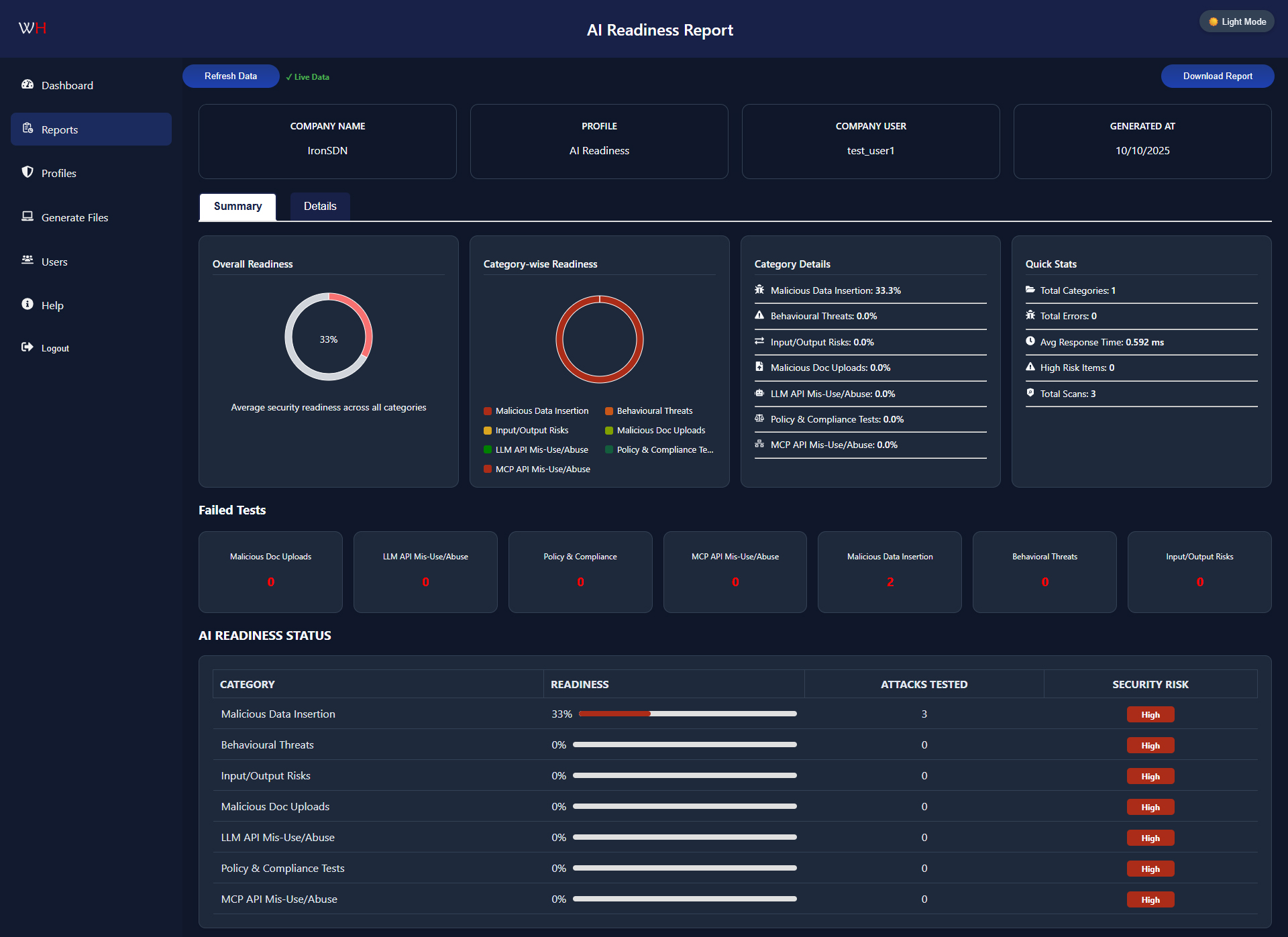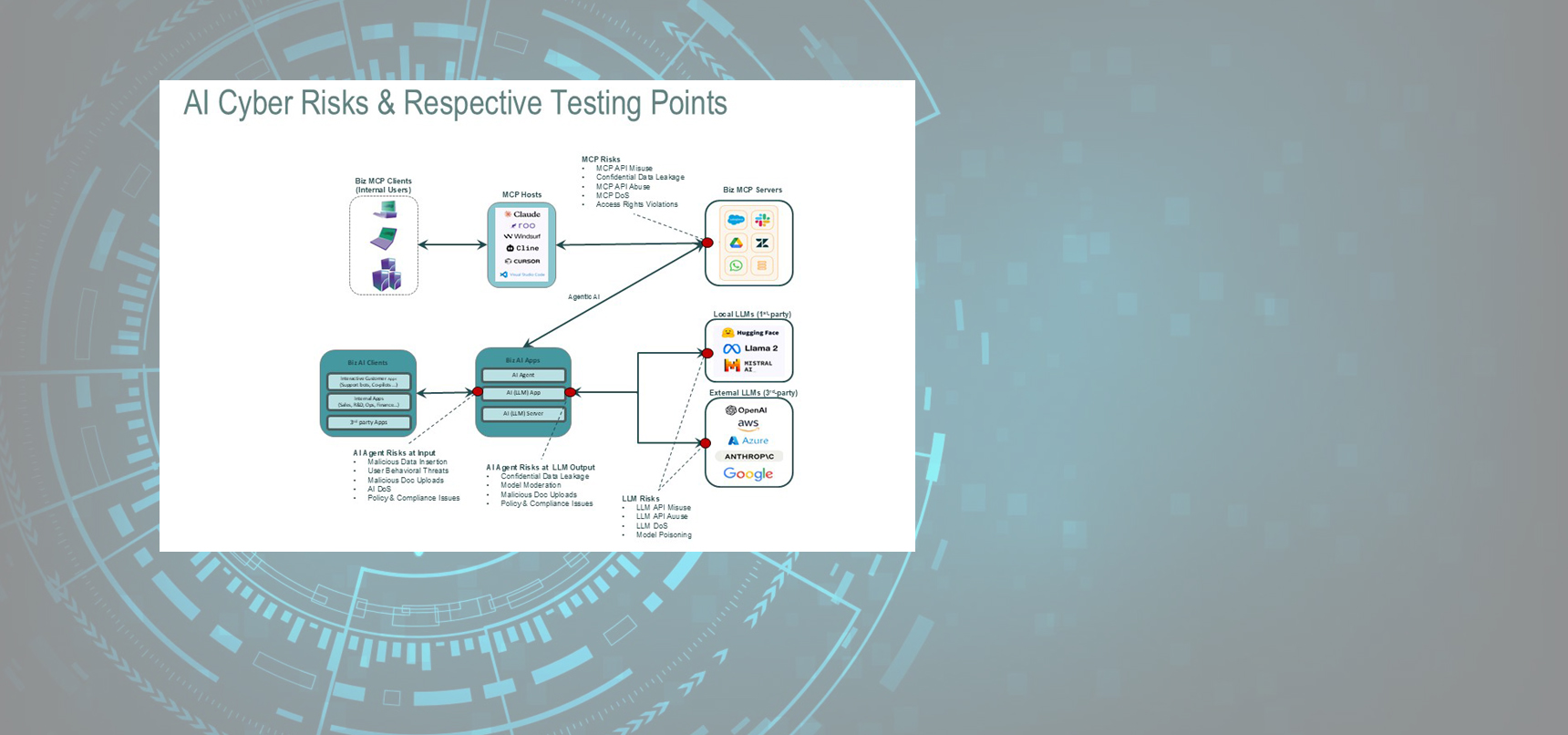WhiteHaX AI Readiness Verification Platform
Continuously Verify AI-deployment before it becomes a Business Risk
Overview

WhiteHaX AI Readiness Verification Platform is an enterprise-grade, automated testing and validation, DAST/SAST platform designed to harden Generative AI and Large Language Model (LLM) applications against a comprehensive spectrum of security threats and compliance risks. By simulating thousands of sophisticated adversarial attacks and policy violations, WhiteHaX provides developers and security teams with actionable intelligence to identify vulnerabilities, prevent data leaks, and ensure regulatory adherence before deployment.
The WhiteHaX AI Readiness platform verifies the full-scale cyber-readiness of Agentic-AI deployments (including those using RAG) while allowing businesses to measure AI responsiveness and performance through average response time measurement of their AI applications.
2. Technical Specifications
| Category | Specification |
|---|---|
| Deployment Model | SaaS (Cloud-Hosted) Management with On-Premise WhiteHaX App (Win, Linux, MaCOS) |
| Integration | REST API, CLI, CI/CD Pipelines (including SAST/DAST integration) |
| Testing Volume | Capable of executing Hundreds of Thousands of unique test cases per hour per target system. |
| Attack Library | Curated and continuously updated library of 1,000,000+ malicious prompts; 5,000+ malicious docs; Ability to generate custom prompts using Semantically-trained internal LLMs, Hundreds of testing scenarios. |
| Customization | Full customization of prompts using training inputs; Expected results verification as per deployed business-application and other params |
| Report Generation | Detailed PDF/HTML reports with failed prompts/docs and other details, remediation guidance, and compliance gaps. |
| Dashboard | Centralized web dashboard for managing tests, viewing results, and tracking trends over time. |
3. Target Users
- AI Application Developers: Integrate security testing into the development lifecycle (DevSecOps) – along with SAST/DAST tools.
- Security & Red Teams: Proactively find and remediate critical vulnerabilities in AI deployments.
- Compliance & Risk Officers: Audit AI systems for adherence to internal policies and external regulations.
- Product Managers Ensure customer-facing AI features are safe, reliable, and trustworthy.
4. Benefits
- Proactive Security: Shift-left security testing to identify vulnerabilities before they reach production.
- Compliance Confidence: Automate evidence gathering for audits and ensure continuous compliance.
- Protect Brand Reputation: Prevent high-profile security incidents Significantly lower the risk of AI-related data breaches, model theft, confidential data leakage and system compromise via AI endpoints.and biased outputs that cause reputational damage.
- Reduce Risk:: Significantly lower the risk of AI-related data breaches, model theft, confidential data leakage and system compromise via AI endpoints.
- Save Time & Resources: Automate thousands of tests that to continuously validated AI business deployments.
5. Supported Use-Cases & Deployment Types
WhiteHaX is designed to test a wide array of AI deployments, including following example use-cases:
- Public-Facing Chatbots & Assistants
- Internal Copilots and Productivity Tools
- AI-Powered Search and Retrieval Systems
- Code Generation Assistants (e.g., GitHub Copilot alternatives)
- Content Generation and Marketing Platforms
- Research & Development Applications in variety of industries
- AI APIs serving multiple downstream applications
Key Features & Capabilities
WhiteHaX's AI testing modules are organized into five core pillars of AI security:
- Direct Prompt Injection: Systematically attempts to override initial system prompts to force unintended model behavior.
- Indirect (Jailbreak) Attacks: Tests thousands of sophisticated jailbreak techniques (e.g., DAN, character 扮演, encoded instructions) designed to bypass ethical safeguards.
- Backdoor Triggers: Injects hidden triggers and anomalous patterns into seemingly benign inputs to test for unexpected and malicious outputs.
- Model Hijacking: Attempts to subvert the AI's intended task to perform a hidden, malicious objective.
- Model Drift Simulation: Monitors and measures output consistency over time to detect performance degradation and concept drift.
- Model Poisoning Attempts: Simulates training data poisoning attacks by testing how the model responds to inputs designed to corrupt future learning or fine-tuning cycles.
- Multi-Step Malicious Intent: Executes complex, multi-prompt attack sequences that appear harmless individually but achieve a malicious goal collectively.
- Bias & Influence Detection Probes the model for inherent biases related to demographics, ideology, and culture. Tests susceptibility to persuasion and influence campaigns.
- PII Leakage Detection: Inputs prompts designed to trick the model into revealing sensitive Personally Identifiable Information (PII) from its training data or context window.
- Confidential Data Leakage: Tests for accidental exposure of proprietary business data, intellectual property, or confidential internal information.
- Output Bias Analysis: Systematically audits outputs for fairness, identifying discriminatory language or unfair recommendations across protected classes.
- Toxicity Analysis: Evaluates both user inputs and AI outputs for toxic, hateful, explicit, or harassing content.
- File Format Fuzzing - Tests the entire document processing pipeline with a vast library of maliciously crafted files, including:
- MS-Office Docs (Word, Excel, PPT etc.): Macros, embedded objects, hidden content, and exploit code.
- PDFs: : Malicious embedded objects such as images, hyperlinks, and corrupted structures.
- Images (JPG, PNG, SVG, etc.): Steganography, pixel flood attacks, malicious SVG scripts, and prompt injections embedded in image metadata.
- QR Codes: QR codes containing malicious URLs, prompt injections, or other exploit code.
- Invalid API Request Flooding: Stress-tests API endpoints with malformed requests, high-volume traffic, and various encoding attacks.
- Key/Token Abuse Simulation: Tests authentication and rate-limiting controls by simulating token theft, replay attacks, and permission bypass attempts.
- Anomalous Access Pattern Detection: Generates traffic patterns indicative of scraping, data exfiltration, and brute-force attacks.
- Access Rights Abuse: Attempts to access prompts, data, or functionalities outside the scope of a given user's API key permissions.
- LLM DoS: Attempts to flood the business application by simulating various types of Denial-of-Service attacks such as Resource DoS, Cost-Overrun DoS, Model-Corruption DoS etc.
- GDPR Privacy Tests: Validates the system's ability to handle Right to Be Forgotten (erasure) requests and prevents PII leakage as mandated by GDPR.
- HIPAA Tests: Specifically tests for scenarios that could lead to the exposure of Protected Health Information (PHI).
- OWASP Top-10 for LLM Checks: Full test suite aligned with the Open Web Application Security Project's top vulnerabilities for LLMs (e.g., LLM01: Prompt Injection, LLM02: Data Leakage).
- Custom Regulatory Frameworks: Allows for the creation of custom test cases to meet specific industry or regional regulations (e.g., CCPA, PCI DSS, EU AI Act).
- Response time for Prompt Inputs: Measure avg response time of input prompts and improve it for optimal response by allocating necessary resources.
- Response time of Document Processing: Measure avg response time of uploaded docs for better throughput.
- Overall System Performance: : Track AI system’s performance trend over time to monitor for degradation or improvements.
Contact: For more information, please visit www.WhiteHaX.com or contact sales team at sales@WhiteHaX.com.
Proprietary and copyrighted material of IronSDN, Corp. ©️ Copyright 2022. All rights reserved.
For more information, visit www.WhiteHaX.com




